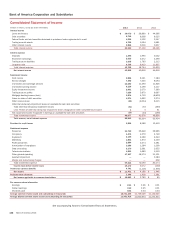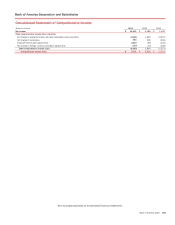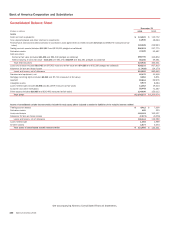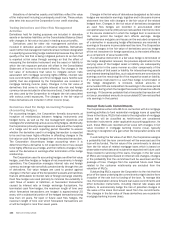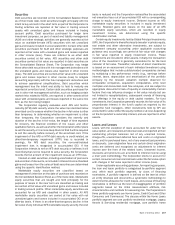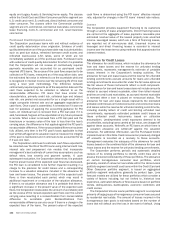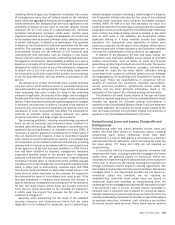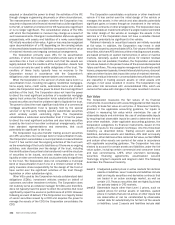Bank of America 2013 Annual Report Download - page 156
Download and view the complete annual report
Please find page 156 of the 2013 Bank of America annual report below. You can navigate through the pages in the report by either clicking on the pages listed below, or by using the keyword search tool below to find specific information within the annual report.154 Bank of America 2013
Bank of America Corporation and Subsidiaries
Notes to Consolidated Financial Statements
NOTE 1 Summary of Significant Accounting
Principles
Bank of America Corporation (together with its consolidated
subsidiaries, the Corporation), a bank holding company (BHC) and
a financial holding company, provides a diverse range of financial
services and products throughout the U.S. and in certain
international markets. The term “the Corporation” as used herein
may refer to Bank of America Corporation individually, Bank of
America Corporation and its subsidiaries, or certain of Bank of
America Corporation’s subsidiaries or affiliates.
The Corporation conducts its activities through banking and
nonbanking subsidiaries. The Corporation operates its banking
activities primarily under two charters: Bank of America, National
Association (Bank of America, N.A. or BANA) and FIA Card Services,
National Association (FIA Card Services, N.A. or FIA).
Principles of Consolidation and Basis of Presentation
The Consolidated Financial Statements include the accounts of
the Corporation and its majority-owned subsidiaries, and those
variable interest entities (VIEs) where the Corporation is the
primary beneficiary. Intercompany accounts and transactions have
been eliminated. Results of operations of acquired companies are
included from the dates of acquisition and for VIEs, from the dates
that the Corporation became the primary beneficiary. Assets held
in an agency or fiduciary capacity are not included in the
Consolidated Financial Statements. The Corporation accounts for
investments in companies for which it owns a voting interest and
for which it has the ability to exercise significant influence over
operating and financing decisions using the equity method of
accounting or at fair value under the fair value option. These
investments are included in other assets. Equity method
investments are subject to impairment testing and the
Corporation’s proportionate share of income or loss is included in
equity investment income.
The preparation of the Consolidated Financial Statements in
conformity with accounting principles generally accepted in the
United States of America requires management to make estimates
and assumptions that affect reported amounts and disclosures.
Realized results could differ from those estimates and
assumptions.
The Corporation evaluates subsequent events through the date
of filing with the Securities and Exchange Commission (SEC).
Certain prior-period amounts have been reclassified to conform to
current period presentation.
New Accounting Pronouncements
Effective January 1, 2013, the Corporation retrospectively adopted
new accounting guidance from the Financial Accounting Standards
Board (FASB) requiring additional disclosures on the effect of
netting arrangements on an entity’s financial position. The
disclosures relate to derivatives and securities financing
agreements that are either offset on the balance sheet under
existing accounting guidance or are subject to a legally enforceable
master netting or similar agreement. This new guidance addresses
only disclosures and, accordingly, did not have an impact on the
Corporation’s consolidated financial position or results of
operations.
Effective January 1, 2012, the Corporation adopted
amendments from the FASB to the fair value accounting guidance.
The amendments clarify the application of the highest and best
use, and valuation premise concepts, preclude the application of
“blockage factors” in the valuation of all financial instruments and
include criteria for applying the fair value measurement principles
to portfolios of financial instruments. The amendments also
prescribe additional disclosures for Level 3 fair value
measurements and financial instruments not carried at fair value.
The adoption of this guidance did not have a material impact on
the Corporation’s consolidated financial position or results of
operations. For the related disclosures, see Note 20 – Fair Value
Measurements and Note 22 – Fair Value of Financial Instruments.
Effective January 1, 2012, the Corporation adopted new
accounting guidance from the FASB on the presentation of
comprehensive income in financial statements. The Corporation
adopted the new guidance by reporting the components of
comprehensive income in two separate but consecutive
statements. For the new statement and related information, see
the Consolidated Statement of Comprehensive Income and Note
14 – Accumulated Other Comprehensive Income (Loss).
On January 15, 2014, the FASB issued new guidance on
accounting for qualified affordable housing projects which permits
entities to make an accounting policy election to apply the
proportionate amortization method when specific conditions are
met. The new accounting guidance is effective on a retrospective
basis beginning on January 1, 2015 with early adoption permitted.
The Corporation is currently assessing whether it will adopt the
proportionate amortization method. If such method is adopted,
the Corporation does not expect it to have a material impact on
the consolidated financial position or results of operations.
In December 2012, the FASB issued a proposed standard on
accounting for credit losses. It would replace multiple existing
impairment models, including an “incurred loss” model for loans,
with an “expected loss” model. The FASB announced it would
establish the effective date when it issues the final standard. The
Corporation cannot predict at this time whether or when a final
standard will be issued, when it will be effective or what its final
provisions will be. The final standard may materially reduce
retained earnings in the period of adoption.
Cash and Cash Equivalents
Cash and cash equivalents include cash on hand, cash items in
the process of collection, cash segregated under federal and other
brokerage regulations, and amounts due from correspondent
banks, the Federal Reserve Bank and certain non-U.S. central
banks.
Securities Financing Agreements
Securities borrowed or purchased under agreements to resell and
securities loaned or sold under agreements to repurchase
(securities financing agreements) are treated as collateralized
financing transactions except in instances where the transaction
is required to be accounted for as individual sale and purchase
transactions. Generally, these agreements are recorded at the
amounts at which the securities were acquired or sold plus accrued
interest, except for certain securities financing agreements that
the Corporation accounts for under the fair value option. Changes






